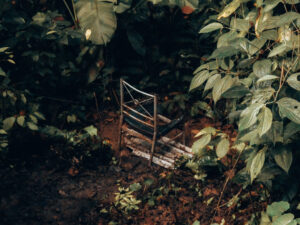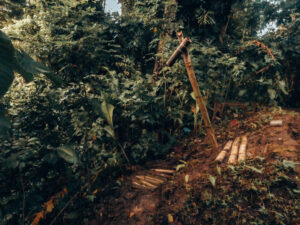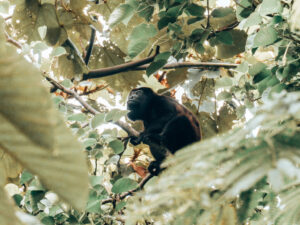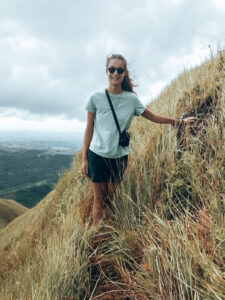Guest Blogger Emma Spiers wrote an article for us about their experiences while living in the Jungle of Costa Rica.
‘Bath in a creek’ was the first thing that really stood out as “okay, this could be intense”. Living a sustainable lifestyle in the tropical jungle of Costa Rica IS a bit intense, but surprisingly easy. For most living in the jungle sounds challenging but it actually isn’t! For a total of 7 weeks, Ty and I volunteered and lived on a sustainable cacao and banana farm. Let us tell you more about it!
To say the least, we did not know what to expect from this living in the jungle experience, but our time there was made memorable and special for so many reasons. The farm is owned by a family who has lived there for over 10 years, for them, the jungle is their home, and they have an incredible way of making the jungle your home too.
Perhaps it is because of the living conditions that force you to get on with life that makes living in the jungle feel like home quickly. On the first day, “poo” was a highly discussed topic. With no electricity, no running water, no plumbing, and no bathroom, the subject of poo, and poo holes were often talked about. Ty even dug his own poo hole and fashioned an old chair as a makeshift toilet seat, and it was brilliant. Like we said, true jungle life, right?

But living in the jungle is more than just that…
Bucket and creek baths were the next things we had to adapt to. Farm work itself is already physically demanding, let alone the heat and humidity, and when it rains, the mud! If you have volunteered in a jungle before, you are probably familiar with these circumstances while living in the jungle. I should mention as well that the whole property is situated on a mountain in the jungle so just walking from the bottom to the top is a workout and a half, welly boots were essential to even walk up and down when it’s muddy. A shower or a nice soak would be heavenly after getting so sweaty and muddy but that is not an option. Instead, there was the nearby creek where the only downfall was the swarms of mosquitoes we first experienced when we arrived. With no mosquitoes, you can sit back and look up into the trees, see the sun streaming through the jungle, maybe watch or hear the howler monkeys calling. It was a special place to have your shower and it’s strange how normal it became.
On the whole, everything became second nature very quickly. Sustainable living and living in the jungle also opens your eyes to what you really need in life. What is essential and what is just extra. I found that a lot of things in life are just extra luxuries. Of course, the first shower we had after living in the jungle felt amazing and you miss some things, but you know that you can live without them and that’s one of the biggest lessons I learned from our time on the farm.
True luxury while living in the jungle
One example of a ‘luxury’ while living in the jungle was a bamboo shower. Homemade by Ty, it was literally an off-cut piece of bamboo that he used an old nail to poke holes into (showerhead….), tied onto another longer piece of bamboo, and dug into the ground. This became our shower! It worked brilliantly as long as you had someone there to pour peanut butter jars of water into it… maybe the luxurious part was that you didn’t have to slide down the muddy path to the creek if it was a rainy day, or maybe it was literally the fact that it kind of resembled a shower? Either way, the view from the shower was through a clearing in the trees and it was beautiful, people pay a lot of money for views but for us, that was one thing we had in abundance.

Rainy days
Another thing that became so precious to me while being at the farm and living in the jungle was the rain. Filtered rainwater was relied on for drinking, and rainwater was also collected to serve every other water need. For cooking, washing, laundry; you always consider how much water you are using and become so conscious not to waste any. I have always lived like that anyway but when living in the jungle and there is no rain for a week and the water tanks get lower and lower, we would get so excited for the rain. Plus, you can sit back and know that everything you planted is getting a nice drink so win-win!
Living in the jungle also means…
It may not be for everyone, I certainly miss having a toilet nearby in the night, rather than sleepily having to put on welly boots and trudge out into the jungle to pee. But for a while, using only what you need, where nothing goes to waste, and being stripped back to the bare essentials teaches you that living sustainably and living in the jungle is so easy to do.
So yes:
Being immersed in nature makes it all feel worth it. Sharing your home with the wildlife is incredible and it was still exciting each time you saw a sloth or poison dart frog. Get woken up by the howler monkeys at dawn or see the capuchin monkeys jumping through the trees. Because this all happens while living in the jungle.

It’s hard to put into words how nature is used for a purpose without sounding like we were taking advantage of it. But nature provided everything from the edible and medicinal plants available, or a mud path you can make into steps to make a path more accessible. Even the bamboo we hiked up a mountain to collect (everything had to be used to make the climb and the effort of dragging a 5m long heavy bamboo pole through the jungle worth it). We never took more than we needed and that’s all there is to it.
For me that time living in the jungle meant not just inhabiting a space, it was truly living with the jungle. Every day we dealt with the mud, rain, heat, and humidity, which doesn’t go away when you go to bed or cook or lounge in a hammock. Nor does the sounds of the jungle or the persistent bugs. We truly lived with the jungle.
Written by: Emma Spiers



